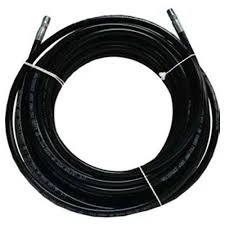Low Pressure Hose Leak in Power Steering System Troubleshooting Guide
Understanding Power Steering Low Pressure Hose Leaks
Power steering is an integral component of modern vehicles, allowing for smoother steering and enhanced maneuverability. The power steering system typically comprises several components, including a pump, steering gear, and hoses. Among these, the low pressure hose plays a crucial role in transferring hydraulic fluid from the reservoir to the steering gear and return. When this hose develops a leak, it can lead to a variety of issues, affecting both vehicle performance and safety. This article will delve into the causes, symptoms, and solutions for power steering low pressure hose leaks.
Causes of Low Pressure Hose Leaks
The low pressure hose is designed to withstand the hydraulic pressure exerted by the power steering system. However, several factors can lead to leaks
1. Wear and Tear Over time, hoses can become worn due to age and exposure to heat, oil, and environmental factors. Rubber hoses, in particular, can dry out and crack, leading to leaks.
2. Improper Installation If the hose is not installed correctly, it may be too tight or too loose, leading to premature failure. A tight bend in the hose can create stress points that may eventually rupture.
3. Contamination The power steering fluid can become contaminated with debris or moisture, which may degrade the hose material over time. This can lead to cracks or softening of the hose, resulting in leaks.
4. High Temperatures Power steering systems generate heat during operation. Excessive temperatures can weaken the hose, causing it to fail. This is particularly true in high-performance or older vehicles where cooling systems may not be as efficient.
Symptoms of a Low Pressure Hose Leak
Detecting a leak in the low pressure hose early can prevent more severe issues down the line
. Here are some common symptoms to watch for1. Fluid Leaks One of the most obvious signs is the presence of power steering fluid underneath the vehicle. This fluid is typically a reddish or pinkish color and has a distinctive smell.
2. Whining Noise A failing power steering system may produce whining or groaning noises when turning the steering wheel, indicating that the pump is struggling due to low fluid levels.
power steering low pressure hose leak

3. Heavy Steering If the vehicle’s steering becomes noticeably heavier or requires more effort to turn, this may be a sign that the power steering system is not functioning correctly.
4. Warning Light Some vehicles are equipped with a dashboard warning light that indicates issues within the power steering system. If this light illuminates, it may signal a fluid leak or other component failure.
Solutions for Low Pressure Hose Leaks
If you suspect a leak in your vehicle’s low pressure hose, it’s crucial to address the issue promptly to avoid extensive damage. Here’s what you should do
1. Inspect the Hose Start by visually inspecting the low pressure hose for any signs of cracks, fraying, or dampness around connections.
2. Check Fluid Levels Monitor the power steering fluid level. If it is consistently low, this may indicate a leak that needs urgent attention.
3. Replace the Hose If a leak is confirmed, the most effective solution is to replace the damaged hose. Ensure that the new hose is properly installed to prevent future issues.
4. Flush the System If contamination is suspected, it may be beneficial to flush the power steering system before installing a new hose. This will remove any debris or old fluid that could contribute to further failures.
5. Consult a Professional If you are unsure about diagnosing or fixing the issue yourself, seek assistance from a qualified mechanic. They can provide a thorough inspection, ensuring the entire power steering system is functioning correctly.
Conclusion
A leak in the power steering low pressure hose can lead to a range of problems that affect the performance and safety of your vehicle. By being proactive—monitoring for symptoms, addressing issues promptly, and ensuring routine maintenance—you can keep your power steering system in optimal condition. Regular checks and timely repairs can extend the lifespan of your vehicle’s steering system, providing a safer and more enjoyable driving experience.
-
Ultimate Spiral Protection for Hoses & CablesNewsJun.26,2025
-
The Ultimate Quick-Connect Solutions for Every NeedNewsJun.26,2025
-
SAE J1401 Brake Hose: Reliable Choice for Safe BrakingNewsJun.26,2025
-
Reliable J2064 A/C Hoses for Real-World Cooling NeedsNewsJun.26,2025
-
Heavy-Duty Sewer Jetting Hoses Built to LastNewsJun.26,2025
-
Fix Power Steering Tube Leaks Fast – Durable & Affordable SolutionNewsJun.26,2025

